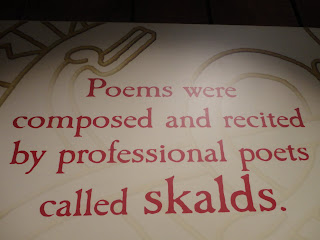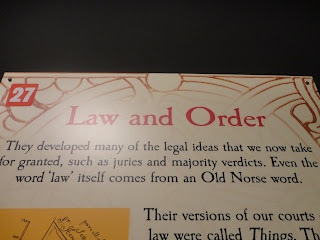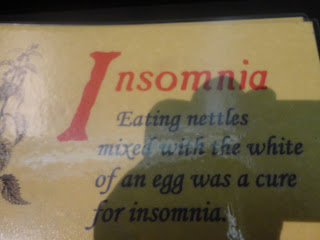Today I went to Dublinia and I had a fantastic time!
Dublinia is an interactive museum where people can go and learn about Viking and Medieval Ireland. The museum is broken up into different sections. These sections are Viking, Medieval Ireland and Archaeology. Each level has models that help bring history alive. People can push buttons and pull levers to reveal answers. One can even dress up as a Viking or a person of the Medieval age. Little souvenirs can be made in some of the exhibits.
I learned so much about all these different aspects of history. You might think that this place is just for children, but that is not the case. There is something for everyone. There is enough to keep children entertained and enough academic stuff to keep the history buff believing the trip is worth while.
I certainly believe that Dublinia is a trip that everyone in Dublin should take. It is a fun way to learn about the early history of the city and the country as a whole. The Vikings have such a major influence in Dublin's culture, that it is critical, I believe, to know some about them.
Below are pictures that I took of Dublinia and the information that I learned :)

Dublinia!
 A Viking greeted me at the door.
A Viking greeted me at the door.  Viking warrior. Viking warriors didn't actually hear the horn helmets that are usually associated with them. These horn helmets are believed to be part of ceremonial events that took place in the Scandinavian area before the Viking era.
Viking warrior. Viking warriors didn't actually hear the horn helmets that are usually associated with them. These horn helmets are believed to be part of ceremonial events that took place in the Scandinavian area before the Viking era.  War. Vikings were known as warriors. They usually went to other countries to gain wealth. They would sack monasteries for riches. They were not anti religion, for many of them converted to Christianity. Monasteries held the wealth in those days, so the Vikings took over monasteries for pure monetary gain.
War. Vikings were known as warriors. They usually went to other countries to gain wealth. They would sack monasteries for riches. They were not anti religion, for many of them converted to Christianity. Monasteries held the wealth in those days, so the Vikings took over monasteries for pure monetary gain.  Trade. The Vikings traded with surrounding territories. They worked closely with other cultures so over time they actually married into these other groups.
Trade. The Vikings traded with surrounding territories. They worked closely with other cultures so over time they actually married into these other groups.  Woman worshiping the Viking gods. The Vikings were a polytheistic society, for they believed in many gods. Valhalla was their idea of heaven for Viking warriors. Vikings had to die in battle before they could enter heaven. Odin was a main god in Viking mythology. He was the god of war and kings. The god Thor was his son. He was the most popular Viking god and was the god of thunder. He had the qualities that the Vikings valued most: strength and determination.
Woman worshiping the Viking gods. The Vikings were a polytheistic society, for they believed in many gods. Valhalla was their idea of heaven for Viking warriors. Vikings had to die in battle before they could enter heaven. Odin was a main god in Viking mythology. He was the god of war and kings. The god Thor was his son. He was the most popular Viking god and was the god of thunder. He had the qualities that the Vikings valued most: strength and determination.  A compass. The Vikings used this to navigate the sea. They also used landmarks and weather for direction.
A compass. The Vikings used this to navigate the sea. They also used landmarks and weather for direction.  A chest filled with what Viking sailors would bring with them while they were on the sea. As you can see, it is not much. The Vikings were excellent sailors. One of their favorite tool was the axe. It would be used to do jobs around the ship as well as a weapon.
A chest filled with what Viking sailors would bring with them while they were on the sea. As you can see, it is not much. The Vikings were excellent sailors. One of their favorite tool was the axe. It would be used to do jobs around the ship as well as a weapon.  Viking weapons. We know so much about Viking weapons because a warrior would be buried with his weapons.
Viking weapons. We know so much about Viking weapons because a warrior would be buried with his weapons.  "Cattle die, kindred die, every man is mortal:/But I know one thing that never dies,/the glory of the great dead".
"Cattle die, kindred die, every man is mortal:/But I know one thing that never dies,/the glory of the great dead".  Viking burial. Sometimes a warrior would be buried in a ship. Many Vikings were cremated. Whether they were cremated or not, the family would leave grave goods for the dead. These would be some sort of offerings to the dead to make sure they had items in the afterlife. Warriors would be buried with their sword. Some sort of stone would be put in remembrance on the dead.
Viking burial. Sometimes a warrior would be buried in a ship. Many Vikings were cremated. Whether they were cremated or not, the family would leave grave goods for the dead. These would be some sort of offerings to the dead to make sure they had items in the afterlife. Warriors would be buried with their sword. Some sort of stone would be put in remembrance on the dead.  Slave trader. The Vikings took many Slavic people as slaves. Some believe that the word slave comes from the word Slavic.
Slave trader. The Vikings took many Slavic people as slaves. Some believe that the word slave comes from the word Slavic.  Viking house. These houses varied in what they were made out of. Most of the time, whatever material was abundant was used.
Viking house. These houses varied in what they were made out of. Most of the time, whatever material was abundant was used.  J.R. Tolken, when writing "The Lord of the Rings", used Norse culture to inspire the books. For example, the elf language he created is influenced by the Norse language.
J.R. Tolken, when writing "The Lord of the Rings", used Norse culture to inspire the books. For example, the elf language he created is influenced by the Norse language.  Ragnarok was the Viking's armagaden, if you will. They believed that many major events, like a great battle, natural disasters and the world being consumed by fire, would kill the main gods of Norse mythology and all humans, except for two. The surviving gods would meet and the world would resurface new and fertile, and the two humans would repopulate the world.
Ragnarok was the Viking's armagaden, if you will. They believed that many major events, like a great battle, natural disasters and the world being consumed by fire, would kill the main gods of Norse mythology and all humans, except for two. The surviving gods would meet and the world would resurface new and fertile, and the two humans would repopulate the world. Different plates. The metal plate would be used by the merchant. The wooden plate would be used by his apprentice. The wooden plate is where the phrase "a square meal" is founded. And the servants would get any food that was left over.
Different plates. The metal plate would be used by the merchant. The wooden plate would be used by his apprentice. The wooden plate is where the phrase "a square meal" is founded. And the servants would get any food that was left over.  This symbol would be a sign that a town had the permission to have a fair. In order to have a fair, the town had to get permission from the king. This symbol was like the king's blessing on the town to host a fair.
This symbol would be a sign that a town had the permission to have a fair. In order to have a fair, the town had to get permission from the king. This symbol was like the king's blessing on the town to host a fair.  A scale. In Medieval times, they did not have a standard currency, so a scale was deemed to be the official currency of the fair to making trading equal. The fair even had to have their own guards and courts to settle trading disputes.
A scale. In Medieval times, they did not have a standard currency, so a scale was deemed to be the official currency of the fair to making trading equal. The fair even had to have their own guards and courts to settle trading disputes.  Entertainment was a large section of fairs. They had games to play and see exotic animals, like bears.
Entertainment was a large section of fairs. They had games to play and see exotic animals, like bears.  People could hire a scribe to write a will, letter etc for them. Most of the population in Medieval times were illiterate.
People could hire a scribe to write a will, letter etc for them. Most of the population in Medieval times were illiterate.  I don't think I would want to see a doctor in Medieval times. Medicine back then combined classical knowledge with alchemy, astrology, fortune telling and traditional herbal cures.
I don't think I would want to see a doctor in Medieval times. Medicine back then combined classical knowledge with alchemy, astrology, fortune telling and traditional herbal cures.  There was no cure for leprosy. The person had to carry around a bell to warn people that they had leprosy.
There was no cure for leprosy. The person had to carry around a bell to warn people that they had leprosy.  One of the ways a person could die was due to violence. During the Medieval times, it was not safe to wonder off into unknown territories.
One of the ways a person could die was due to violence. During the Medieval times, it was not safe to wonder off into unknown territories.  Leprosy was another death threat to people. Leprosy would distort the face. There was no cure for it, so leprous were social outcasts of society.
Leprosy was another death threat to people. Leprosy would distort the face. There was no cure for it, so leprous were social outcasts of society.  View from St. Michael's tower. The church, which is where Dublinia is located, is from the 17th century.
View from St. Michael's tower. The church, which is where Dublinia is located, is from the 17th century.







































































No comments:
Post a Comment